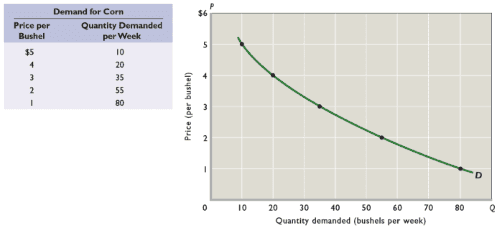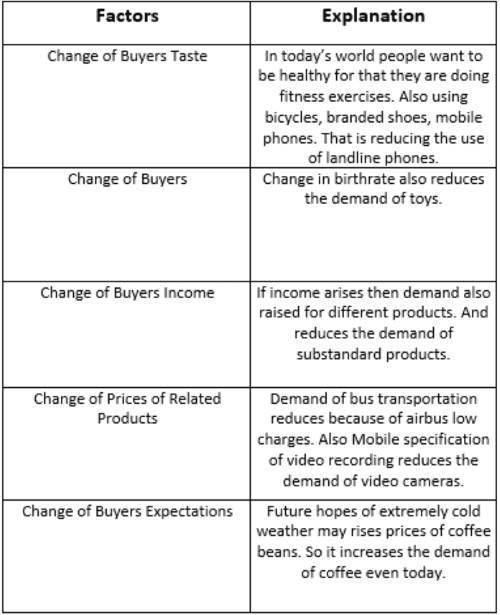Demand Curve Definition Economics? Before we know what the demand curve is and the shifting of the demand curve we need to understand demand itself.
Demand Curve Definition Economics?
A Demand is defined as the willingness and ability to buy a specific product in a specific quantity at a specific price over some time. Demand can be plotted easily in a table or on a graph.
Demand Curve in Economics-Factors that Influence demand:
When demand is shown on a graph, it has a peculiar shape that is distinctly known as the demand curve. This demand curve demonstrates the various prices and the demand for the product in respective to it.
Remember when we are discussing demand and analyzing the demand curve, only willingness isn’t important but the buyer should have the ability to buy the product also.
Simultaneously, if the buyer can buy the product. But is not willing to buy it, even then we don’t consider it while we discuss demand and the demand curve.
The following graph shows the relationship between the various prices of corn and the quantity of corn a particular consumer would be willing and able to purchase at each of these prices.
In the figure, if the price of corn were $5 per bushel, our consumers would be willing and able to buy 10 bushels per week. If it was $4, the consumer would be willing and able to buy 20 bushels per week; and so forth.
To be meaningful, the quantities demanded at each price must relate to a specific period—a day, a week, a month.
Saying “A consumer will buy 10 bushels of corn at $5 per bushel” is meaningless. It is better if we say “A consumer will buy 10 bushels of corn per week at $5 per bushel” to make it more meaningful. Unless a specific time is stated, we do not know whether the demand for a product is large or small.

Law Of Demand Curve:
The whole economy is governed by demand and supply and demand is controlled by the Law of Demand that can be easily demonstrated in the demand curve too.
A fundamental characteristic of demand is this:
Other things equal, as price falls, the quantity demanded rises, and as price rises, the quantity demanded falls. In short, price and quantity demanded are inversely related to each other. This is why the demand curve always slopes downwards. In economics, this statement is known as the demand curve.
We can also explain the law of demand in terms of income and substitution effects.
Income Effect:
The income effect suggests that a lower price of a product means an increase in the buying ability of the buyer and thus a relative increase in demand as well. A higher price works oppositely and results in a decrease in demand for the product.
Substitution Effect:
The substitution effect suggests that a lower price ensures that the product has an edge over its substitutes that are now relatively more expensive. It means the demand for the product will increase automatically.
Similarly increasing the price will mean a decrease in own demand and shift of buyer’s interest towards the competitive substitute.

Factors that Influence Demand Curve:
The demand for a certain product is influenced by not only price but various other factors too. A few of which are:
- Taste
- Income
- Price of other related goods
- Consumer expectations
The following table shows the factors that affect the demand curve of a certain product.
Taste:
Sometimes, due to advancements in technology and day to day needs, the taste of consumers shift from one product to the other. For example with the introduction of cars in the market, lesser people bought horses or carts afterwards.
This ultimately causes a reduction in demand for one product and an increase in demand for the other product.
Income:
Most of the time, an increase in the income of a household causes a relative increase in demand for that product. Consumers typically buy more steaks, furniture, and electronic equipment as their incomes increase. Conversely, the demand for such products declines as their incomes fall.
For example, an increase in income causes the buyers to buy more luxury items than they did before.
Price of other Related Goods:
A change in the price of a related good may either increase or decrease the demand for a product, depending on whether the related good is a substitute or a compliment.
A substitute good can be used in place of another good. If the price of a substitute increases the demand for its good also increases and vice versa.
A complementary good is used together with another good. When the price of complementary goods increases then ultimately the demand for own good decreases and vice versa.
Consumer Expectations:
Changes in consumer expectations may shift demand. A newly formed expectation of higher future prices may cause consumers to buy now to “beat” the anticipated price rises, thus increasing current demand.
That is often what happens in so-called hot real estate markets. Buyers rush in because they think the price of new homes will continue to escalate rapidly. Some buyers fear being “priced out of the market” and therefore not obtaining the home they desire. Other buyers—speculators—believe they will be able to sell the houses later at a higher price.
Whichever their motivation, these buyers increase the current demand for houses.
Similarly, a change in expectations concerning future income may prompt consumers to change their current spending.
For example, first-round NFL draft choices may splurge on new luxury cars in anticipation of lucrative professional football contracts. Or workers who become fearful of losing their jobs may reduce their demand for, say, vacation travel.
In summary, an increase in demand—the decision by consumers to buy larger quantities of a product at each possible price—may be caused by:
- A favourable change in consumer tastes.
- An increase in the number of buyers.
- Rising incomes if the product is a normal good.
- Falling incomes if the product is an inferior good.
- An increase in the price of a substitute good.
- A decrease in the price of a complementary good.
- A new consumer expectation that either prices or income will be higher in the future.
See Also: Toronto New Years Eve 2022 – Canada.
More Tags: How does a demand curve work? What is the demand curve and supply curve? Why is the demand curve important in economics? Why it is called the demand curve? what is demand, the law of demand definition economics, supply curve definition economics, demand schedule definition economics, what is supply in economics, types of the demand curve, demand curve diagram






















